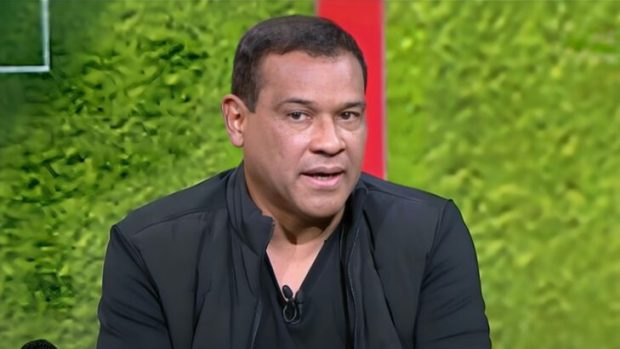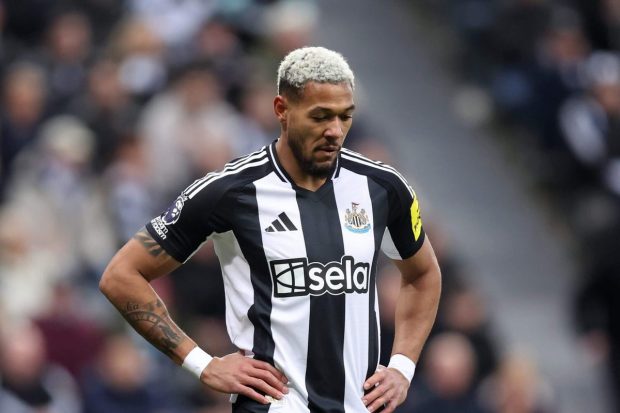Tetairoa McMillan joined the Arizona Wildcats as the 12th-ranked recruit in the nation, at any position, and as the top recruit out of the state of California, according to Rivals. He didn’t take long to make an impact. He had over 700 receiving yards and eight touchdowns as a true freshman — one of my favorite stats this draft cycle is that McMillan had 39 receptions as a freshman, and 32 of those receptions went for a first down or touchdown — and continued to produce at a high level in his sophomore and junior years as well, racking up a combined 174 receptions for over 2,700 yards over those final two seasons.
McMillan is currently sitting at the top of most public draft boards, including mine, as the top wide receiver prospect for the 2025 NFL Draft (in the non-Travis Hunter category). McMillan, though, is not perceived as a clear blue-chip type of prospect and a unanimous top prospect at his position. And he’s even seen his name start to slip underneath other receiver prospects.
As much as I like Matthew Golden, Emeka Egbuka and several other pass catchers in this year’s class, I still see McMillan as not only the clear-cut top receiver prospect in this class, but a prospect near the top of the draft. Which I reflected on my last big board with McMillan as the No. 3 overall prospect.
Advertisement
Tetairoa McMillan’s biggest strengths
Why perceived weakness isn’t an issue
How ecosystem impacted his evaluation
Tetairoa McMillan plays every bit his size, which opens up the playbook
What McMillan brings to the table is exactly what you’d expect when you first see his 6-foot-4, 219-pound frame. He’s a big receiver that plays big.
Some bigger receivers simply don’t play big, making you question their own previous basketball accolades and checking exactly how many rebounds they were grabbing in high school. McMillan projects to be a true “X” wide receiver (outside receiver, primarily isolated in trips formations). His size and ball skills simply scream of a player that was a high-end basketball player (and volleyball player, too!).
Advertisement
His hand-eye coordination is excellent. His hands are excellent. He truly snatches the football. He has the utmost confidence in his hands and uses every inch of his arm length to and get the football. Go balls along the sideline turn from 50/50 ventures into something more like 80/20 investments when targeting McMillan. He is not only comfortable high pointing for throws like the former basketball and volleyball player that he is, but can adjust his hands and contort his body to come down with the football on a frighteningly consistent basis.
Goal line fades might make most fanbases pull their hair out because of their ineffectiveness. With McMillan, they are back on the menu. Even against all-world talents like Travis Hunter.
No, Tetairoa McMillan doesn’t have long speed. And no, it isn’t a problem
The main concern that crops up with McMillan is his long speed. McMillan isn’t a sloth, but he is definitely not scaring defenses deep on a down-to-down basis. His reported 40 times from his pro day were in the 4.52-4.55 range, matching what he shows on tape.
Advertisement
But McMillan isn’t rigid as he works to top gear. He is constantly changing gears and throttling his speeds to keep cornerbacks uneasy. So while he isn’t threatening receivers with high-octane speed, he’s still able to create space and separation on breaking routes because of how he is able to keep defenders off balance.
McMillan might not have gamebreaking top-end speed but he is still able to accelerate and burst in and out of his route breaks with the best of them. This shows up not only when he’s creating yards after the catch, but also when he’s breaking out of stop and hitch routes.
McMillan is winning off the line and still creating space on these routes, even when the cornerback is pressed or is heavily favoring one side because of safety help. Cornerbacks feel threatened against McMillan even if he’s not a consistent threat to torch them deep. His releases at the line of scrimmage, along with his body coordination and size, forces defenders to keep thinking about how they’re going to get attacked. McMillan uses that uncertainty to create separation, and he has the ball skills to win on any contested catches that did happen.
Advertisement
Even on more vertical routes, McMillan is still a valid threat because of his excellent catching range and size. Watch the first clip against BYU in the tweet below. McMillan can seem like he’s coasting off of the line of scrimmage, but he’s still eating up ground. You can then see the rapid acceleration to threaten the safety before breaking on his route, with his adjustment for the catch being the cherry on top.
So McMillan isn’t the next coming of DeSean Jackson as a deep ball threat. But he is still a vertical threat because of that catching range and ability to adjust for throws and come down with the football.
I also think McMillan shows real polish as a route runner already, with a fairly advanced route tree from a college player. Not only with his ability to change speeds, he can really sink and bend on his route breaks, which is especially more impressive given his 6-4 frame.
Advertisement
McMillan plays big when working through contact and when the ball is in the air. But before the ball is thrown (and after he catches it), he moves like a much smaller player.
Something that can hinder taller and bigger receivers is that they will get “stuck” at the top of their routes. Pausing, rising up, and/or taking an extra step or two before having to break on their route. This is not an issue with McMillan (again, watch his tempoing on the route below).
McMillan aligned on the outside a majority of the time, but got a steady helping of work from the slot throughout his career, too. His ability to get in and out of routes is highlighted as he goes to work on underneath routes. It’s also a testament to his overall route tree that he was a valid option from multiple spots across the formation.
McMillan can not only sink to come out of his route breaks, he can plant and get north with the ball in his hands in a hurry, too. McMillan’s fluid athleticism also shows up with his ability to turn quickly and then having the agility to make the first defender miss with the ball in his hands. His confidence in his hands let him grab the football at full speed and turn into a runner without breaking stride. He has a very effective juke move that truly seems to surprise defenders as they are left lunging for air.
Advertisement
That plus-acceleration shows up as he gets going in a hurry and he can really build up steam once he gets into open space. McMillan might not be catching explosive plays down the field too often, but he was able to generate dozens of explosives by being devastating in the short and intermediate areas, making the first defender miss, and then picking up steady yards afterward with his balance, agility and play strength.
Why it can seem like Tetairoa McMillan is coasting at times
McMillan’s play effort was also something that has gathered whispers as a concern among evaluators. And to be honest, it was never really an issue for me when I was reviewing Arizona’s games. McMillan can seem like he’s coasting on a route at times, but I do think a part of that is just perception with his easy athleticism and long legs that eat up yards. There is also Arizona’s quarterback play that might have had an effect on McMillan’s effort. Or perceived effort.
Advertisement
Noah Fifita, Arizona’s quarterback and McMillan’s longtime college and high school teammate, had a shaky 2024. Fifita can be an exciting player, but he was wildly inconsistent when working from the pocket last year, often turning down open throws to enter scramble mode and extend plays with his legs. This led to a lot of volatility in Arizona’s offense and also a lot of effort being expended by Arizona’s players (with little success, too).
No FBS wide receiver ran more routes in 2024 with an extended time to throw (four or more seconds) than McMillan’s 100 such routes — more than double the average of 44.8 among the 271 qualifying wide receivers. A whopping 23.2% of his total routes were on pass plays that took four or more seconds, the second-highest rate among all receivers in FBS last season. Frequent extended plays can essentially double the distance run by players on a given play. It’s a natural part of football, but can start to wear down teams (on both sides) as games go along, especially if the quarterback ended up taking sacks or throwing the ball away at a high rate (Fifita led all FBS quarterbacks last season with 38 throwaways).
Advertisement
And when a team is losing, and losing consistently (often by big points), then it can turn simply exhausting as the quarterback goes off-script once again and there’s another sprint added to the play. In 2024, 66.6% of McMillan’s routes were when Arizona was trailing, the sixth-most among the same qualifying FBS wide receivers. In comparison to last year’s group of first-round WRs, only Ricky Pearsall (55.6%) and Xavier Legette (51.%) were above 50%. When the Wildcats lost last year, it often came with an early pummeling from the other team. It’s not an excuse, but more just to paint the picture of the ecosystem in which McMillan was playing.
There is a silver lining with all of Fifita’s frequent forays outside the pocket. McMillan’s feel for space, burst, and catching range were all highlighted during scramble drills. McMillan might have been a multi-sport athlete in high school, but he has a real understanding for playing wide receiver.
Watch McMillan’s burst before and after his reception as Fifita extends the play. McMillan would constantly be going full effort as yet another pass play was extended (as he probably knew that’s how he was going to get the ball).
And McMillan’s feel for space wasn’t just an eye test. He had more receiving yards (242) and receptions (10) than any other receiver in FBS on extended plays. Part of that was the outright frequency of them, but also speaks to McMillan’s ability to stay friendly to the quarterback.
Advertisement
That’s not to excuse everything with his effort. There are times when you wish McMillan would impose his size more as a blocker. But he isn’t outright bad, more just “fine” in that area, with his finishing wavering depending on the score and whether he was a little gassed from a recent reception. But in the rare instances where Arizona was still in a tight game, McMillan would actually show off some real strength and effort, as well as attention to detail on the little things like adjusting to block the safety when they’re part of the run fit.
I can be pretty harsh as an evaluator when I see what I perceive as a lack of consistent effort or “want-to” with a football player. And no red flags came up with McMillan’s down-to-down effort. This was the first play against rival Arizona State last year, and remember, Arizona was sputtering to finish their 4-8 season. Does this look like a lack of effort or “want-to” from McMillan?
Comparisons for Tetairoa McMillan
I’m going to share a few player comparison that came to mind when watching McMillan. Remember this is more of a size and overall play style comparison, not a career projection for a given player. I just like to look at the more optimistic upside comparison for how a player might look in the NFL.
Advertisement
With McMillan’s size, fluidity, and ball skills, A.J. Green came to mind, along with Tee Higgins. Both players were around 6-4 with similar builds to McMillan when coming out of college and were timed in the 40 in the same range as McMillan (4.48 for Green, 4.59 for Higgins). These are true “X” ball-winning wide receivers that McMillan will major in as a pro.
But McMillan’s work from the slot and ability to create a steady helping of yards after catch makes me think of another wide receiver who used to ply their trade in the state of Arizona: former Cardinals great Larry Fitzgerald. Again, this is not a one-to-one match of what I think McMillan’s career will be, but more of a size and stylistic comparison. It’s lofty, but there are some real similarities of build, ball skills, balance, and body coordination between McMillan and Fitzgerald. Fitzgerald was never a burner, but was so effective because of his size, polish, hand-eye coordination and agility, along with having a real knack for being quarterback-friendly against zone coverage. He went from being a bully on the outside before evolving into an excellent power slot receiver in the second half of his career under Bruce Arians.
McMillan is slightly taller and leaner. But go back and watch some of Fitzgerald at Pittsburgh in what should have been a Heisman-winning career (I’ll never forget you, Jason White), there’s more similarities to McMillan than you’d think.
Cowboys, Packers are good fits for Tetairoa McMillan
The Dallas Cowboys have become a fit for me that I really like for McMillan. As an “X” who can move around the formation, it would open up opportunities for CeeDee Lamb to go to work from his best area: the slot.
Advertisement
McMillan’s consistent ability to win on isolated routes like stops and hitches also make him a great fit for the Cowboys as Dak Prescott has loved passing concepts that feature those routes throughout his career, no matter who the offensive play caller is. The Cowboys might want a true burner to pair with Lamb, but I still think this would be a dynamite pairing that makes a good amount of sense.
If McMillan continues to fall, a team like the Packers could also make sense, either by staying put at pick 23 or moving up slightly to somewhere in the teens. The Packers have a group of interesting pass catchers but desperately missed someone who could beat man coverage last year, especially in isolated situations. A pass catching group of McMillan, Jayden Reed, Romeo Doubs, and Tucker Kraft would be exciting and holistically makes sense. With other young players like tight end Luke Musgrave and Dontayvian Wicks (plus an injured Christian Watson) on the depth chart, too.
Overall, I think McMillan has the upside of a real No. 1 option in a good passing game. He could eat targets on a “real” route tree in a real passing attack, and his skill set and ability to line up across the formation fits into any type of offense. I just like the fact that McMillan can be productive in the flow of the offense. He can thrive on plays designed for him, as well as a player deeper in the progression or on broken plays. He has a game that can make an impact early for a team in the red zone because of his exceptional ball skills, too. I even think his floor is relatively high for such a volatile position because of the “simple” things he can contribute to right away and the fact his route tree already has some clean branches on them, too. At the very worst, he looks like a complementary player that can share the targets with another strong option.
This news was originally published on this post .










Be the first to leave a comment